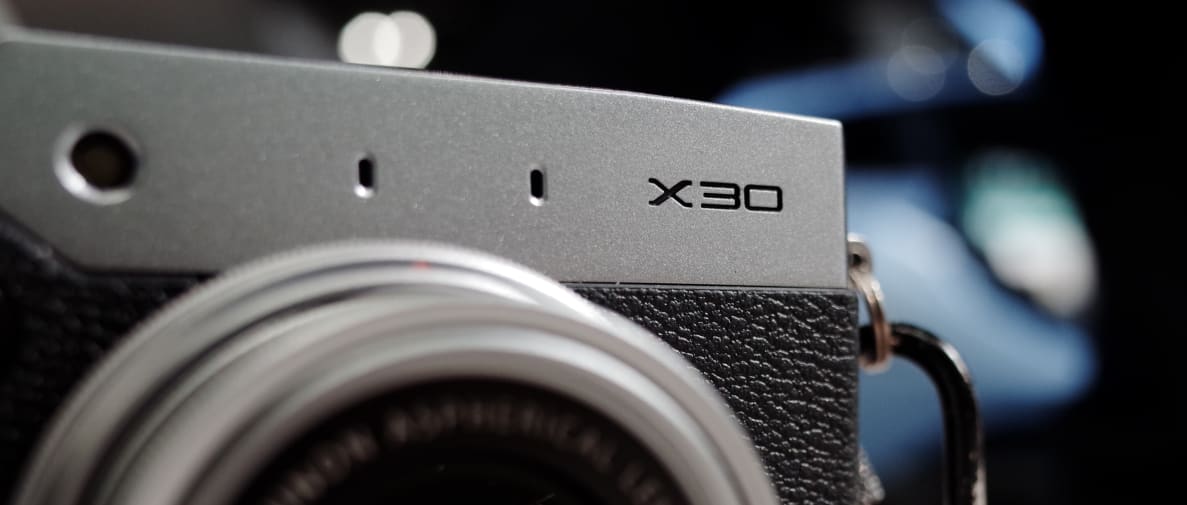When we reviewed the X20 last year, we noted that even though it was a great little shooter, there were things we would change. The idea of an optical viewfinder, while catnip for the nostalgic, was better on paper than it was in the real world. We also felt that the controls were out of sync with the rest of the camera’s superb build. Enter the Fujifilm X30 (MSRP $599.95). The company has taken everything we loved about the X20, and given the rest a thorough re-thinking. What results is a decidedly modern take on the excellent concept that was explored in the X10 and X20.
Design & Handling
The X20’s come back a changed camera.
We were a little caught off-guard with how much the X30 deviates from the X10 and X20. Even though this model’s parentage is unquestionable, it just doesn’t look much like its predecessors. We think it’s mostly a change for the better, especially thanks to thoroughly improved ergonomics.
{{ photo_gallery "design" }}
A comfy ledge juts out of the front of the camera, giving your fingertips something just substantial enough to grab on to. The shape of the camera is only one part of the equation: The X30 also benefits from a new, grippier kind of textured leatherette. It’s substantially more tacky than the slippery surface of the X20. Nearby the new grip is a new custom function button.
The hallmark feature of the quirky X10 and X20 was how you turned the camera on—a feature that returns in the new X30. Instead of an on/off switch, Fujifilm designed the lens zoom ring to act as the power. Twist the lens to full wide to turn it on, and when you’re done, turn it the other way past full wide to power down. The X30 powers on and off in the same way, but also gains a new control ring around the lens, behind the manual zoom control. It’s well-placed and turns smoothly.

Cleaner, tighter rear controls almost make up for the crummy ones on the X10 and X20.
The buttons around the back of the camera are thoroughly reworked, too. A d-pad replaces the old, cheap-feeling vertical control wheel, and the four keys around the OK button all have shortcuts assigned to them. Above the d-pad is the important Q button, just within reach of your thumb. A horizontal control dial near the top of the camera is an improvement, but the action we experienced when turning it felt a little sloppier than we’d hoped.
Finally, how could we leave out the tilting LCD? A trick the X30 clearly learned from the X-T1, this is a great feature for such a compact camera. Between the new grip and the flexible, multi-angle screen, the X30 should be a way better camera for one-handed use than its predecessors.
Features
Addressing our biggest gripes.
So, you’ve probably noticed that this X camera’s missing an optical viewfinder. Where’d it go? Fujifilm has obviously listened to feedback, and replaced it with an impressive 2.36m-dot OLED electronic unit. Second only to the EVF you’d find in the much pricier X-T1. While the panel itself is much smaller, the 0.65x magnification in play makes the picture you’ll peer at extremely usable. Lag wasn’t an issue, even under the uneven lighting of the Photokina show floor. Furthermore, the information layout rotates when you flip from landscape to portrait. We’re ecstatic with this addition—it’s a big leap forward in usability for the X30.
Our other problem with the X10 and X20 was that battery life was straight-up atrocious. We even talked to a Fujifilm representative at the booth that said he had to sometimes carry four batteries with him to ensure a full days’ shooting with his X20. Now, the X30 gets a substantial boost in runtime. It inherits the larger capacity battery from the Fujifilm X100-series for a total of 470 photos with the CIPA rating. On top of that, the X30 also has USB charging, so a quick boost is never far away.

Our favorite part of the X20, its sensor and lens, continues on in the X30 unchanged.
Our favorite feature of the X10 and X20 hasn’t changed a lick, and we’re happy to say it. The sharp, fast Fujinon zoom 7.1–28.4mm f/2–2.8 lens is back and just as good as ever. Behind the lens is a decently sized 2/3” X-Trans CMOS sensor with 12 effective megapixels and phase detection pixels. Autofocus was fast when we tried it out at Fujifilm’s booth, locking on without too much trouble.
WiFi comes along for the ride, something other recent Fujifilm camera models—like the X100T—have picked up as well. Film simulation modes continue to be an important Fuji feature, and the X30 brings the brand-new Classic Chrome, along with old favorites like Provia, Velvia, Astia, Pro Neg. High and Standard. If you miss the way film made your memories look, these modes might provide the pictures you’re looking for.
Conclusion
What it loses in uniqueness, it adds back in refinement.

If our experience at Photokina is any indication, the X30 should be another excellent camera for Fujifilm.
While we fell in love with the X10 and X20 in spite of their flaws, we can’t help but appreciate the X30 for how it fixes everything we didn’t love. It’s rare to see a camera company address so many niggles in a single product refresh, but the X30 is proof positive that Fujifilm is striving to please its hardcore fans while attracting new ones. The bright OVF the X30 lacks will be missed, but the OLED EVF that replaces it will undoubtedly impress those who hadn’t considered Fuji in the past.
So, as we bid adieu to the X20, we welcome the X30 with open arms for all its improvements. This might be a changed camera, but the fact that the same sensor and lens continue onward are clear reminders of what helped make this model great.
Meet the tester
Brendan is originally from California. Prior to writing for Reviewed.com, he graduated from UC Santa Cruz and did IT support and wrote for a technology blog in the mythical Silicon Valley. Brendan enjoys history, Marx Brothers films, Vietnamese food, cars, and laughing loudly.
Checking our work.
Our team is here for one purpose: to help you buy the best stuff and love what you own. Our writers, editors, and lab technicians obsess over the products we cover to make sure you're confident and satisfied. Have a different opinion about something we recommend? Email us and we'll compare notes.
Shoot us an email



